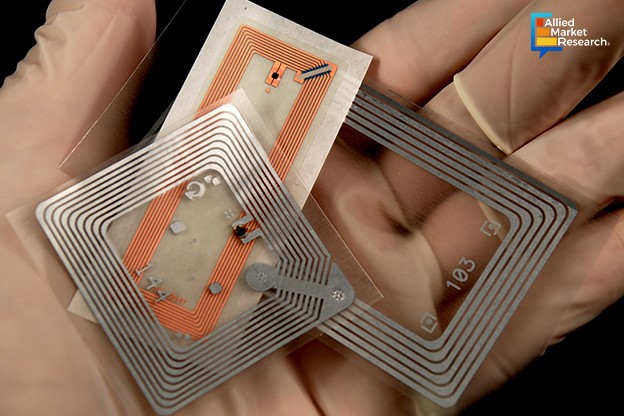Evolution of the RFID Tags Industry: How Should Businesses Adapt to the Changing Dynamics of this Industry?

23 Apr
2024
Highlights
- Introduction
- New technologies in the RFID tags sector
- Role of IoT in transforming the sector
To address some of the limitations of wired communication technologies, several wireless communication technologies have been developed over the years, one of which is RFID technology. RFID technology uses principles of electromagnetism and electrostatic coupling in the radio frequency spectrum for identification. Like any other wireless technology, RFID consists of a scanning antenna, a receiver, and a transponder. The receiver and the scanning antenna together form the RFID reader while the transponder is installed in the RFID tag. These tags typically contain a substrate, integrated circuit (IC), and antenna which help store and transmit data with the RFID reader or other devices wirelessly.
How has the RFID tags industry been evolving in the past few years?
RFID technology is one of the most widely used wireless communication technologies in the world. A major evolutionary step in the RFID tags industry is that today RFID tags are used in different end-use industries like healthcare, aerospace and defense, warehousing and logistics, entertainment, etc. For instance, these tags are used regularly in hospitals and clinics for identifying patients and authorizing access to qualified surgeons and medical practitioners in restricted areas like operation theaters.
RFID technology is of huge importance to the warehousing and logistics industry; this technology helps vendors track their goods, monitor their routes, and ensure their safe delivery. Moreover, it also aids retail stores and warehouses in managing their inventory efficiently. Thus, RFID technology forms the backbone of the modern supply-chain management sector. Hotels, restaurants, sports stadiums, concert halls, casinos, and many such entertainment and hospitality centers have also made changes in their systems to accommodate RFID technology.
Another aspect of the evolution of this industry is the transformation of the RFID system itself. Earlier, the range of traditional low-frequency RFID systems was between a few inches to 5 feet. However, in the past few years, companies have been able to develop long-range, high-frequency, and ultra-high-frequency systems that have a range of more than 25 feet up to 60 feet. This development has opened numerous growth opportunities in the industry as ultra-high frequency RFID tags can now be used for various other applications like toll collection on highways. The rising use of these long-range systems is expected to help the ultra-high frequency segment of the industry to garner an absolute revenue of $4116.8 million in the 2022-2032 period.
Exploring the potential of the integration of IoT and RFID technology
The use of the Internet of Things and 3D printing is another vital development in RFID technology. IoT has improved the capabilities of RFID technology, especially when it comes to asset tracking and inventory management. The accuracy and precision with which goods can be tracked in real-time have increased greatly by integrating IoT with RFID tags. Many companies, understanding the potential of this development, have launched products that harness the power of these technologies.
For instance, Pepfuels, an online diesel order booking system, announced the launch of an IoT-RFID device. Considered India’s first location-based fuel delivery device, it is a server-monitored reader that is connected to the fuel dispensing machine. The device will ensure that there is zero loss in fueling and will help save fuel cost and time, along with a substantial reduction in pilferage.
Similarly, Xindeco IOT, a leading RFID tags manufacturer in China, in August 2023, announced the expansion of its product portfolio by launching three new products under the new Impinj M800 series of RAIN RFID systems. The company released a statement after the launch saying the read sensitivity of the three products is much better than conventional RFID tags due to the integration of IoT technology. As per the company, these RFID systems are suitable for retail apparel, pharmaceutical, logistics, and healthcare industries.
Apart from IoT technology, additive manufacturing techniques such as 3D printing have also helped enhance the quality of RFID systems. These tags have, over the years, become more compact and lighter which makes them easier to carry. Furthermore, the research on advanced materials has led to the manufacturing of tags that are made from metals or liquids that enhance their sensitivity, while improving their sturdiness.
To summarize, RFID technology has transformed greatly in the past few decades or so. The applicability of this technology has increased and various innovations like IoT are being incorporated in it. The development of ultra-high frequency RFID tags has also played a significant role in improving the growth rate of this industry. Advancements like 3D printing will further create new investment opportunities in this sector.
For tips and suggestions on how businesses must capitalize on the opportunities offered by the industry, feel free to contact us.

Akhilesh Prabhugaonkar
Author's Bio- Akhilesh Prabhugaonkar holds a bachelor’s degree in Electronics Engineering from the reputed Vishwakarma Institute of Technology. He has a special interest in the fields of forensics, world history, international relations and foreign policy, sports, agriculture, astronomy, security, and oceanography. An ardent bibliophile and melophile, Akhilesh loves to write on topics of his interest and various other societal issues. This love for writing made him enter the professional world of content writing and pursue his career in this direction.
How Manufacturing MOSFET RF Transistors Is a Good Financial Move for Semiconductor Businesses?
Avenue: Entire Library membership of Allied Market Research Reports at your disposal
- Avenue is an innovative subscription-based online report database.
- Avail an online access to the entire library of syndicated reports on more than 2,000 niche industries and company profiles on more than 12,000 firms across 11 domains.
- A cost-effective model tailored for entrepreneurs, investors, and students & researchers at universities.
- Request customizations, suggest new reports, and avail analyst support as per your requirements.
- Get an access to the library of reports at any time from any device and anywhere.
Related Post
-
How are Submarine Cables Transforming Global Connectivity with Enhanced User Experience?
-
Endoscopy Procedures: Transformations in Techniques and Applications
-
AI-Powered Video Analytics: How the Product Actually Works for enterprises
-
Painting Robots: Transforming Precision Coating and Creative Applications
-
Innovations in Pharmacovigilance Systems Advancing Patient Safety
-
Understanding Edge Security: Keeping Data Safe Near the Source
-
Exploring the Use and Advancements of 3D Laser Scanners in Professional Applications
-
Reinforcing Industrial Controls with Smarter Tools and Training








